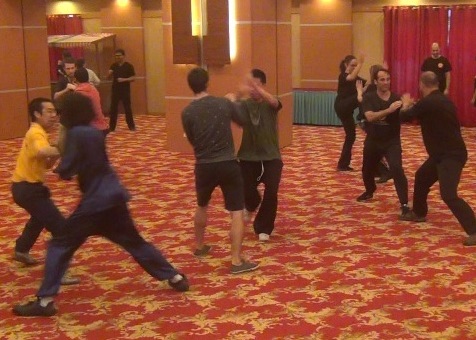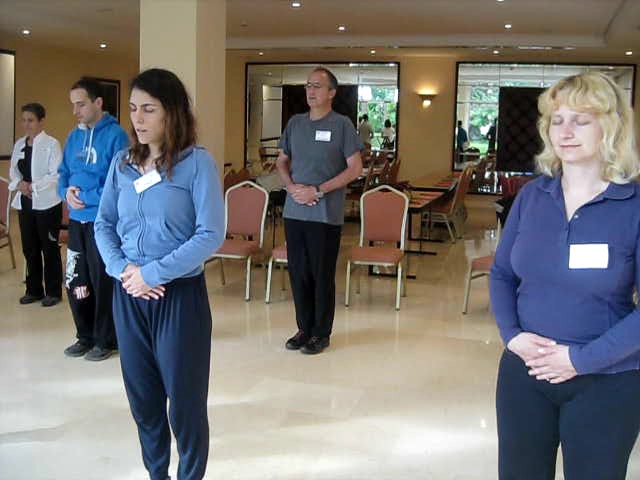THE THREE ULTIMATES OF SHAOLIN KUNGFU -- CHIN-NA, DIM MARK AND NEI KUNG

Course participants at a Dragon Strength course in 2014 practicing dim mark
Question
As Chin-Na is one of the 3 ultimates in Shaolin Kungfu, the other 2 being Dim Mak and Nei Kung, could you elaborate on the differences between the 3 ultimates?
More specifically, how are the effects, applications and philosophy different between Chin-Na and Dim-Mak?
Would there be a reason why an exponent would use Chin-Na over Dim-Mak in certain situations, or vice-versa?
FJ
Answer
Chin-na is disabling opponents by gripping their energy points, wrong their tendons or dislocating their joints. Of the three ways of attack in chin-na, gripping energy points is most frequently used.
Dim mark is dotting energy points to stop energy flow along a certain meridian. Both chin-na and dim mark are combat ending. When energy points are gripped in chin-na, or dotted in dim mark, energy stops flowing along that meridian or meridians or those parts of the opponents’ body, resulting in the opponents being unable to continue fighting.
The other two main ways of subduing opponents in chin-na are separating tendons and dislocating joints. When tendons are torn, they fail to move muscles, and when joints are dislocated, the respective limbs are disabled. Both result in opponents not being able to continue fighting.
The injury of both chin-na and dim mark, however, is reversible. The victims can consult competent masters or Chinese trained doctors to restore their energy flow, repair their tendons and fix their joints.
There are countless ways of attack, but these countless ways can be classified into four categories, namely striking, kicking, felling and chin-na. Chin-na, therefore, is a category by itself. dim mark is one of a sub-category of striking. The main sub-category of striking is hitting with the hand. Strikes can also be executed with the shoulders, elbows, head, hips, buttock, and fingers as in the case of dim mark.
Both chin-na and dim mark use the fingers, but chin-na employs gripping whereas dim mark employs dotting. Chin-na is more physical, and dim mark is energetic. It does not need much muscular strength of hard internal force in dim mark. The dotting is usually gentle, whereas much muscular strength or hard internal force is used in chin-na, thought chin-na masters of a high level may use energy or mind instead of physical force in chin-na.
In this context, nei kung, which means internal art, refers to internal cultivation, as opposed to external movements, or wai kung, especially in combat. Hence, although chin-na and dim mark are highly internal, as it is the internal energy flow of the exponents that distort the energy network of the opponents, they are considered wai kung in this context.
As a rough guide, whatever that is meant for combat and involves movement, is considered wai kung, or external art. Whatever that is meant for internal force and involves health, is considered nei kung. Some examples of nei kung in this context are Sinew Metamorphosis, Abdominal Breathing, and Zen meditation.
While chin-na and dim mark are considered nei kung here, as they are meant for combat and involve movement, they are considered nei kung in another context because its training is through essence, energy and mind.
It should be noted that kungfu and chi kung terms are meant for convenience, and are not definitive like scientific terms.
Hence, the external arts, which in this case are chin-na and dim mark, involve external movements are for combat, whereas the internal arts, like Sinew Metamorphosis, Abdominal Breathing and Zen meditation, involve cultivation of essence, energy and mind, and are for health.
The effects of chin-na and dim mark are similar. Both involve stopping of energy flow, which distort the energy network of opponents, resulting in their becoming sick and inability to continue fighting. If the effects are not taken care of, the damage can be very serious. But in kungfu culture in the past, victims were aware of the danger of such injury, and they would seek treatment from other masters or competent therapists.
Generally, the effects of dim mark are more serious than those of chin-na. Unless the energy blockage is released, victims of dim mark may die, but victims of chin-na suffer from permanent disability. Dim mark injuries usually concern the body, whereas chin-na injuries usually concern the limbs.
In both chin-na and dim mark, application is on energy points. In chin-na the injury is due to pressure applied on energy points, often by muscular strength though internal force is used by high-level masters, which stops the energy flow at those points. Hence, the force applied in chin-na is hard.
In dim mark the injury is due to energy flowing from the exponent to the opponent to distort the latter’s energy network. The force applied in dim mark is soft. In some cases the dotting may stop the opponent’s energy flow at the relevant energy points.
The philosophy of chin-na and the philosophy of dim mark are similar. Both chin-na and dim mark stop the natural energy flow of opponents causing them to lose their combat ability, or to be seriously sick if the energy blockage is not released. Both philosophies are based on compassion, enabling the victims to seek remedy later on.
Calling dim mark the touch of death, which is often described as such, is incorrect. It is true that the victims may die if they do not seek treatment, but the concept behind its application is born of compassion, which is to disable opponents from further fighting but enable them to recover fully later on, instead of breaking their skulls or damaging their internal organs to stop further combat.
The ways chin-na and dim mark are applied, are quite different. The application of chin-na is gripping, whereas that of dim mark is dotting. One is hard, the other is soft. Chin-na is usually applied on limbs, whereas dim mark on the body.
Both chin-na and dim mark are very advanced arts. Not many people, including masters, have a chance to learn either one. Indeed, these arts are considered lost. It is incredible that both these arts are available in our school.
The main reason why an exponent would use chin-na over dim mark, or vice versa, is that he is trained in only one of these two arts, if he is very, very lucky besides having put in a lot of dedicated practice. However, if a rare master knows both arts, his choice of using one over the other is often due to circumstances and not preference.
If the combat circumstance is such that chin-na is favorable, he would use chin-na, if dim mark is favorable, he would use dim mark. It is the same as other combat techniques. If the circumstance is favorable for him to use a palm strike, he would use a palm strike. If the circumstance is favorable for him to use a felling technique, he would use a felling technique. A master who has the very rare opportunity and ability to be trained in both chin-na and dim mark will be spontaneous and versatile. He does not have to be limited to some preferred techniques, which may apply to lesser practitioners.
I am very fortunate to be trained in both chin-na and dim mark. Looking over my sparring and fighting experience, I used chin-na more often than dim mark. In fact, I had not used dim mark at all in sparring or fighting, except when during demonstration I felt my energy accidentally penetrated into students which was similar to dim mark. I asked the students to perform “Lifting the Sky” or similar exercises to generate an energy flow to clear away any possible injury.
I used chin-na more often because during the time I had a lot of sparring with other martial artists, I was trained in chin-na. I also had better control at chin-na, subduing opponents but not hurting them. Dim mark injury had to be more serious before opponents conceded defeat.
Even then, I did not have to use chin-na often when compared to striking (apart from dim mark), kicking and felling. I reserved chin-na for difficult opponents, or when the circumstances arose, but I usually could defeat opponents using simpler techniques.

Students in Spain practicing abdominal breathing
The questions and answers are reproduced from the thread 10 Questions on the 72 Shaolin Arts in the Shaolin Wahnam Discussion Forum.
LINKS
